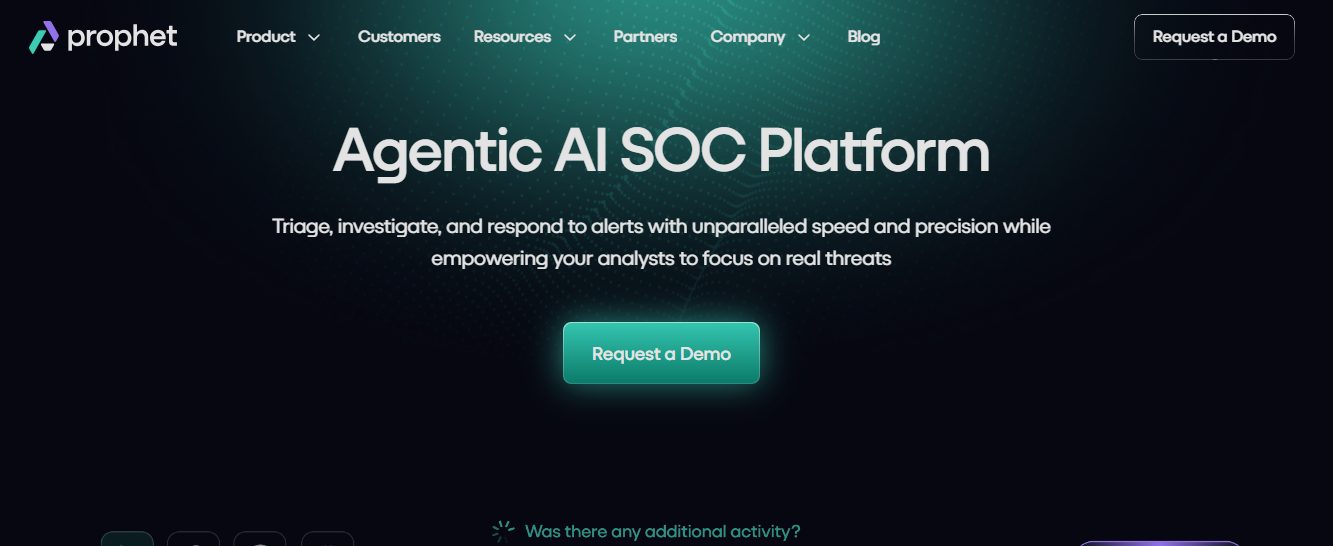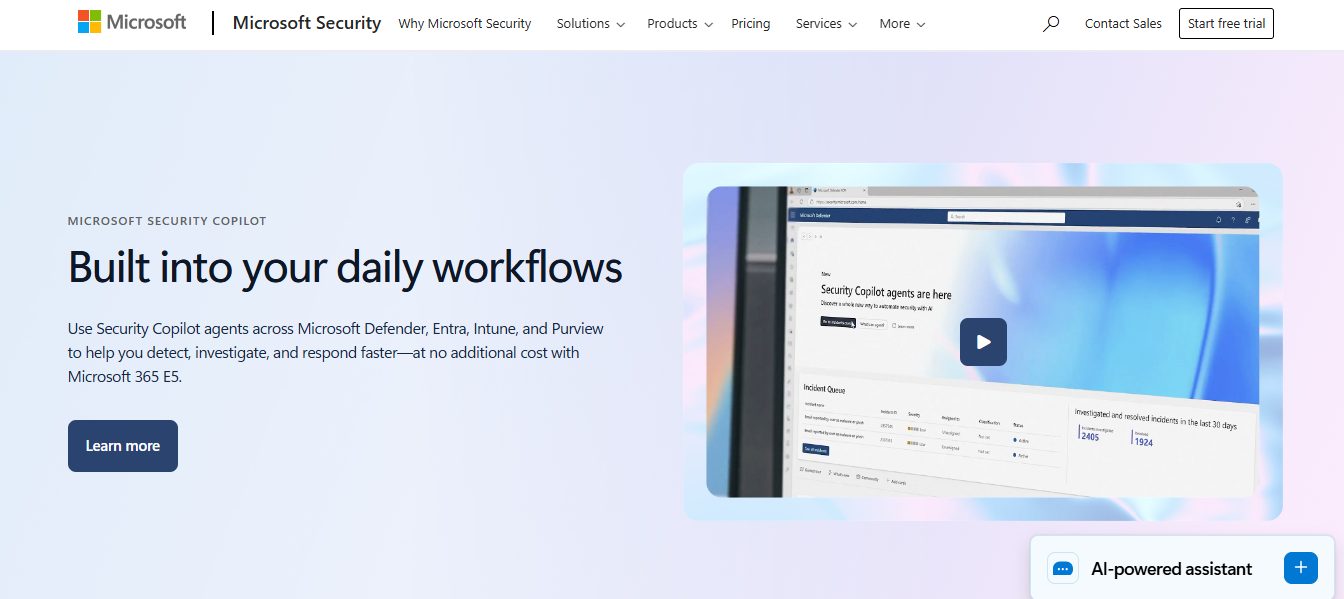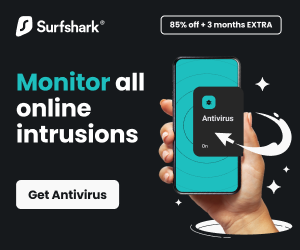In this post, I will highlight the top AI SOC platforms to watch in 2026.
In the age of ever-rising alert volumes, tighter budgets, and sophisticated adversaries, the question is no longer “Should we use AI in the SOC?” It’s “How do we use AI so it augments human analysts rather than replaces them?”.
Here are eight security operations center (SOC) platforms that illustrate how to strike that balance: boosting human insight with AI, rather than sidelining it.
Table of Contents
1. Prophet Security
AI SOC Platform company Prophet Security has the philosophy of augmenting, not replacing. In this case, the platform developed by the company is built for what they call the “agentic AI SOC analyst” model. If your team has a “AI will eliminate me” mindset, Prophet Security offers a different perspective: “AI will make you 10× more effective, but you’re still in the loop.”
Benefits:
- It is designed for cross-tool integration: SIEM, EDR, cloud, and identity which helps avoid creating a “siloed black box”.
- It offers explainable, auditable actions, allowing human analysts to verify what the AI is doing, provide feedback, and learn.
- It places a strong emphasis on human-machine collaboration rather than full autonomy.
Limitations:
Depending on the size of the team and the SOC workload, Prophet Security might not be suitable for every organization. Smaller companies that aren’t dealing with a large number of alerts might not derive the same value as an enterprise. The AI space is also rapidly evolving, and while Prophet Security is a leading AI SOC vendor today with over $40 million in funding, a Proof-of-Value (PoV) is recommended to ensure it operates as promised in your environment.
2. Crogl
This is a startup that views AI as an “Iron Man suit” for analysts. Crogl positions itself as enabling security teams to triage, investigate, and understand alerts at scale, without simply offloading all decision-making to machines.
Benefits:
- It emphasizes fully documented, auditable investigations, so the analyst keeps visibility into what the system is doing.
- It supports deployment in air-gapped or on-premise environments, showing consideration for enterprise constraints.
- Despite its automation fluency, it is built to empower analysts rather than render them redundant.
Limitations:
As a relatively new vendor, Crogl may lack the broader ecosystem integrations and maturity of its larger player counterparts, which can slow adoption down in complex enterprise environments.
3. Mate Security
Another fresh entrant is Mate Security. Its aim is to reduce alert fatigue by pointing AI at the noise, freeing analysts up to focus on the signals.
Benefits:
- It frames the human-AI partnership as one where the AI handles repetitive tasks (triage, enrichment) and the person handles judgment, nuance, and context.
- It highlights transparency and clarity, helping analysts trust the AI’s recommendations rather than blindly following them.
- It suits teams that still have strong analyst coverage and want to cut cognitive load, not eliminate it altogether.
Limitations:
Mate’s feature depth is narrower than that of more established platforms, so larger SOCs may find its capabilities limited when it comes to highly complex investigations.
4. Microsoft Security Copilot
Microsoft Security Copilot lives inside the broader Microsoft ecosystem, which gives it a natural advantage because it plugs straight into the tools many SOCs already use. It adds GenAI to the workflow, but it stays true to its name: it’s a co-pilot, not an autonomous analyst.
Benefits:
- A smooth fit for teams already invested in the Microsoft stack, with almost no integration pains.
- Its scope is intentionally assistive, which keeps analysts in the middle of the process rather than pushing them to the sidelines.
- It reinforces an important truth: even the biggest players with the most automation still rely on humans to make the final decision.
Limitations:
Copilot’s strongest value is evident only in Microsoft-heavy environments; multi-vendor SOCs may see limited benefits.
5. Fortinet SOC Platform
Fortinet’s SOC Platform sits firmly in the “enterprise-grade” category. It brings a unified, AI-driven approach to detection and response, and it’s built for teams that need scale without having to add more tools or skills.
Benefits:
- A tightly connected Security Fabric that pulls telemetry, workflows, and response into one place instead of scattering them across point tools.
- Automation that actually moves the needle: fewer alerts to chase and faster detection and response when things go wrong.
- Broad coverage across endpoint, network, cloud, and identity, which gives teams a clearer view of what’s happening and where the real risks sit.
Limitations:
Its automation can feel as if it lacks transparency if the right guardrails are not put in place. Analysts may lose visibility into why decisions were made, which can cause them to shift into a reactive posture instead of staying in control.
6. IBM Autonomous Threat Operations Machine (ATOM)
The Autonomous Threat Operations Machine, by IBM, is a significant vendor push into agentic SOC automation, encompassing threat hunting, investigation plans, and remediation driven by GenAI.
Key considerations:
- It’s a great brand, with a strong infrastructure, but by its nature, the “autonomous” label signals less human oversight and more machine decision-making.
- For firms comfortable with high automation and willing to build governance around it, it is viable.
- For those who want to keep analysts in tighter control, this kind of model demands strong transparency and clear verification of AI reasoning.
Limitations:
ATOM’s autonomous posture can overwhelm teams who don’t have the time or expertise to validate automated actions at scale.
7. SOC Prime
SOC Prime is another vendor that is interesting for analyst-centric workflows: the platform emphasizes detection intelligence, threat hunting, and equipping analysts with advanced tools, rather than simply replacing them.
Benefits:
- It has vendor-agnostic detection rules and threat hunting platforms that support human-led investigations.
- It places emphasis on “analyst life made easier” rather than “analyst replaced”.
- It’s a good fit for SOCs with strong analyst teams that need smarter tools, rather than fewer analysts.
Limitations:
SOC Prime is not an end-to-end SOC platform; it depends heavily on the customer’s existing tooling and pipelines.
8. Seceon aiXDR
Seceon aiXDR is a platform that is highly focused on automating alert triage, incident response, and workflow orchestration.
Benefits:
- Yet another example of a high-automation approach, which ingests telemetry, limits alert fog, and orchestrates responses.
- It’s good for lean teams and high-volume environments, but again: the more you automate, the more you must keep an eye on the human-judgement component.
Limitations:
Its automation-centric design can lead to over-dependence on machine reasoning if organizations don’t reinforce clear human approval checkpoints.
Comparison Table
| Platform | Strengths | Human-AI Balance | Limitations |
| Prophet Security | Agentic AI model, cross-tool integration, explainability | Human-in-the-loop by design | Requires tuning and operational maturity |
| Crogl | Auditable investigations, on-prem friendly, analyst-centric | Strong human control with transparent automation | Limited ecosystem maturity due to early-stage status |
| Mate Security | Reduces cognitive load, transparent recommendations | Human-led, AI-assisted workflows | Feature set may feel light for complex SOCs |
| Microsoft Security Copilot | Deep Microsoft integration, broad assistive features | Assistive only; analysts remain primary decision-makers | Limited value outside Microsoft-centric SOCs |
| Fortinet SOC Platform | Mature platform, extensive automation | Human oversight needed to counter automation dominance | Can feel opaque without governance discipline |
| IBM ATOM | Strong infrastructure, autonomous orchestration | Leans toward machine-driven decisions | High autonomy demands strong validation processes |
| SOC Prime | Detection intelligence, threat hunting tools | Analyst-driven insights | Not a complete SOC platform; depends on external stack |
| Seceon aiXDR | High automation, strong for lean teams | Requires human validation to maintain trust | Risk of over-automation if governance is weak |
FAQs
Q: Why does human-in-the-loop still matter in SOC operations?
AI excels at scale and speed, but analysts bring context, nuance, and risk judgment. Machines can detect anomalies, but humans understand whether the activity is normal for the business, tied to a sensitive asset, or part of a broader strategic risk.
Q: Are fully autonomous SOCs realistic today?
They are emerging, but not yet quite trustworthy enough, particularly for high-stakes environments. Most entities still need analysts to handle verification, escalation, and ethical decision-making. Studies back this up. A recent paper on human-machine co-teaming in SOCs found that collaboration improves agility and reduces cognitive overload.
Q: Which platforms are best for analyst-heavy SOCs?
Prophet Security, Crogl, Mate Security, and SOC Prime are good options where human insight remains central, and the AI acts as an accelerator instead of a replacement.
Q: Which platforms fit lean teams with high alert volume?
Seceon aiXDR, Fortinet SOC Platform, and IBM ATOM lean into automation and can support smaller teams, but still need strong human oversight.
Q: How do I evaluate whether a platform is “too automated”?
Look for transparency gaps such as:
- Are the AI’s decisions explainable?
- Can analysts override actions?
- Is there a clear audit trail? If the answer is “no”, you’re entering black-box territory.
Q: What’s the safest AI operating model today?
The augmented SOC model: AI handles triage and enrichment; people own judgment and high-stakes calls; and the system learns from analyst feedback over time.
INTERESTING POSTS
- Key Functions Performed By The Security Operations Center (SOC)
- 7 Steps to Building A Security Operations Center (SOC)
- Compliance In The Cloud: Why IAM Is Critical
- Blockchain Trends That Are Shaping the Betting Industry
- Bitcoin Prime: A Crypto Trading Bot Review
- BananaGun Bot: The Ultimate Tool for Copytrade and Memecoin Sniping
About the Author:
Meet Angela Daniel, an esteemed cybersecurity expert and the Associate Editor at SecureBlitz. With a profound understanding of the digital security landscape, Angela is dedicated to sharing her wealth of knowledge with readers. Her insightful articles delve into the intricacies of cybersecurity, offering a beacon of understanding in the ever-evolving realm of online safety.
Angela's expertise is grounded in a passion for staying at the forefront of emerging threats and protective measures. Her commitment to empowering individuals and organizations with the tools and insights to safeguard their digital presence is unwavering.










